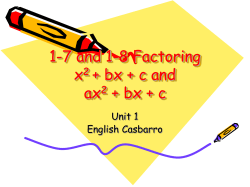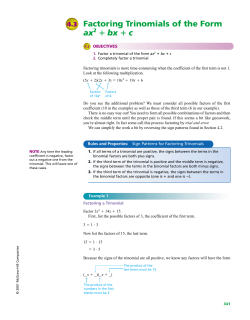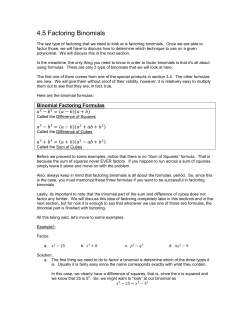
7.3 Workbook Answers - Tequesta Trace Middle
7-3 Factoring x 2 + bx + c Going Deeper Essential question: How can you factor x2 + bx + c? TE ACH Standards for Mathematical Content 1 A-SSE.1.2 Use the structure of an expression to identify ways to rewrite it.* ENGAGE Questioning Strategies • When you factor a trinomial, what type of expression do you expect? the product of two Prerequisites Multiplying binomials binomials Math Background • Using FOIL, which two terms produce the x2 -term in the trinomial? the first Using FOIL, which two terms produce the constant term in the trinomial? the last Using FOIL, which terms produce the x-term in the trinomial? the sum of Students have multiplied binomials to create trinomials. In this lesson, students will begin to do the opposite. They will factor trinomials of the form x2 + bx + c to find the binomial factors of a trinomial. In the next lesson, they will factor trinomials whose leading coefficient is not 1. Factoring a trinomial is an important algebraic skill. At its most basic, it allows students to see the binomial factors that make up a trinomial. But also it will allow students to solve some quadratic equations, find the zeros of some quadratic functions, and aid in graphing quadratic functions; all operations they will perform when they study quadratic equations and functions. the product of the inner terms and the product of the outer terms • When factoring a trinomial, why do you factor the constant into pairs of factors rather than find prime factors? The constant term comes from multiplying the constant terms of two binomials. So, you need two factors that may not be prime. IN T RO DUC E Completing several warm-up exercises will help students see how to factor trinomials Ask students to use FOIL to multiply: A. (x + 4)(x + 3) x2 + 7x + 12 B. (x - 5)(x + 2) x2 - 3x - 10 C. (x + 3)2 x2 + 6x + 9 x2 x x x x x Next, have students factor the following numbers into all possible different pairs of integer factors. x 1 1 1 1 1 A. 12 1 and 12, 2 and 6, 3 and 4, -1 and -12, -2 and -6, -3 and -4 Next, have students place x-tiles and 1-tiles to the left of and above the rectangle. These tiles represent the binomials that are multiplied to obtain the trinomial. In this case, the binomials are x + 5 across the top and x + 1 arranged vertically on the left side. Students can then determine that x2 + 6x + 5 = (x + 5)(x + 1). B. -10 -1 and 10, -2 and 5, 2 and -5, 1 and -10 C. 9 1 and 9, 3 and 3, -1 and -9, -3 and -3 Then ask students how one of each of these pairs of factors is related to each multiplication. Chapter 7 381 Lesson 3 © Houghton Mifflin Harcourt Publishing Company Differentiated Instruction If students are having difficulty in factoring trinomials, algebra tiles can help them visualize the process. Give students algebra tiles to represent the trinomial x2 + 6x + 5 (one x2-tile, six x-tiles, and five 1-tiles). You can either arrange the tiles for students or have the students arrange the tiles to make a rectangle as shown below. Students should write the trinomial x2 + 6x + 5 that is depicted by the tiles. Name Class Notes 7-3 Date Factoring x 2 + bx + c Going Deeper Essential question: How can you factor x2 + bx + c? A-SSE.1.2 1 ENGAGE Factoring Trinomials You know how to multiply binomials: for example, (x + 3)(x - 5) = x2 - 2x - 15. In this lesson, you will learn how to reverse this process and factor trinomials. There are several important things you should remember from multiplying binomials. • Using FOIL, the constant term in the trinomial is a result of multiplying the last terms in the two binomials. • Using FOIL, the x-term results from adding the products of the outside terms and inside terms. You can factor x2 + 10x + 21 by working FOIL backward. Both signs in the trinomial are plus signs, so you know both binomials are of the form x plus something. Therefore, you can set up the factoring as shown below. x2 + 10x + 21 = (x + ? )(x + ? ) To find the constant terms in the binomials, use the information above and follow the steps below. 1) The constant term in the trinomial, 21, is the product of the last terms in the two binomials. Factor 21 into pairs. The factor pairs are shown in the table at the right. Factors of 21 Sum of Factors 1 and 21 22 3 and 7 10 ! © Houghton Mifflin Harcourt Publishing Company 2) The correct factor pair is the one whose sum is the coefficient of x in the trinomial. 3) Complete the binomial expression with the appropriate numbers. ( x2 + 10x + 21 = x + 3 )(x + 7 ) REFLECT 1a. You want to factor x2 - 6x + 8. What factoring pattern would you set up to begin the process? Explain. The first sign is - and the second is +. To get a negative x-term and a positive constant, both binomials must be (x - ? ). The pattern is (x - ? )(x - ? ). 381 Chapter 7 Lesson 3 1b. You want to factor x2 - 2x - 15. What factoring pattern would you set up to begin the process? Explain. Would this pattern also work for x2 + 2x - 15? Explain. Both signs are -. To get a negative x-term and a negative constant, one binomial must be (x + ? ) and the other must be (x - ? ). The pattern is (x + ? )(x - ? ). (x + ? )(x - ? ). 1c. Use factoring patterns to factor x2 + 8x + 16 and x2 - 6x + 9. What do you notice about the factored forms? What special type of trinomials are x2 + 8x + 16 and x2 - 6x + 9? (x + 4)(x + 4), (x - 3)(x - 3); they are squares of binomials. 2 A-SSE.1.2 EXAMPLE A Factoring Trinomials 2 Factor x + 3x - 10. The constant is negative, so you know one binomial will have a subtraction sign. x2 + 3x - 10 = (x + ? )(x - ? ) Complete the table at the right. Note that you are finding the factors of -10, not 10. Since the coefficient of x is positive, the factor with the greater absolute value will be positive (and the other factor will be negative). ( x2 + 3x - 10 = x + 5 B Factors of -10 Sum of Factors -1 and 10 9 -2 and 5 3 )( x - 2 ) Factor x2 - 8x - 48. The constant is negative, so you know one binomial will have a subtraction sign. x2 - 8x - 48 = (x + ? )(x - ? ) Complete the table at the right. Since the coefficient of x is negative, the factor with the greater absolute value will be negative (and the other factor will be positive). ( x2 - 8x - 48 = x + 4 Chapter 7 Chapter 7 )(x - 12 ) 382 Factors of -48 1 and -48 2 and -24 Sum of Factors -47 -22 3 and -16 -13 4 and -12 -8 6 and -8 -2 © Houghton Mifflin Harcourt Publishing Company © Houghton Mifflin Harcourt Publishing Company Yes; the positive x-term and the negative constant also require the pattern to be Lesson 3 382 Lesson 3 2 CLOS E EXAMPLE Questioning Strategies • In part A, explain what would happen to the coefficient of x if the greater of the factor pair were negative. The coefficient of x would be Essential Question How can you factor x2 + bx + c? Trinomials can be factored into two binomials by finding factor pairs for the constant term and determining which factor pair sums to the coefficient of the x-term. negative. • If the problem in part A were to factor x2 - 3x - 10, what would be the factored form? (x - 5)(x + 2) Summarize Have students create a flowchart like the one below for factoring trinomials of the form x2 + bx + c . • How are the factored forms of x2 - 3x - 10 and x2 + 3x - 10 alike? How are they different? The factored forms have the same coefficients for x and the same numbers as constants. The difference is in which binomial involves subtraction. Identify b and c. • After completing part B, determine the factors of x2 + 8x - 48. (x - 4)(x + 12) Find factor pairs for c. EXTRA EXAMPLE Factor. Sum one factor pair for c. 2 A. y + 5y + 6 (y + 3)(y + 2) B. z2 - 9z - 22 (z - 11)(z + 2) Does the sum = b? Highlighting the Standards No Yes 2 EXAMPLE Chapter 7 Write the factored form of x2 + bx + c PR ACTICE Where skills are taught 383 Where skills are practiced 1 ENGAGE EXS. 1–4 2 EXAMPLE EXS. 5–24 Lesson 3 © Houghton Mifflin Harcourt Publishing Company and its Reflect question offer an opportunity to address Mathematical Practice Standard 1 (Make sense of problems and persevere in solving them). Students will need to analyze each trinomial and make conjectures about the form of the binomial factors. Then, they will need to determine which factor pair to use to factor the trinomial. Notes REFLECT 2a. Complete the table below. Assume that b, c, p, and q are positive numbers. Trinomial Form of Binomial Factors x2 + bx + c x2 - bx + c x2 - bx - c or x2 + bx - c ( x + p )( x ( x - p )( x ( x + p )( x ) ) q) + q - q - For the last row in the table, explain how to determine which factor contains a + sign and which factor contains a - sign. If the sign before bx is -, then the factor involving the larger of p or q will have a - sign. If the sign before bx is +, then the factor involving the larger of p or q will have a + sign. PRACTICE Complete the factorization of the polynomial. ( ) ) (d - 3 ) 1. t2 + 6t + 5 = (t + 5) t + 1 ( © Houghton Mifflin Harcourt Publishing Company 3. d2 + 5d - 24 = d + 8 ( )( 2. z2 - 121 = (z + 11) z - ( 4. x4 - 4 = x2 + 2 11 x2 - 2 ) ) Factor the polynomial. 5. y2 + 3y - 4 6. x2 - 2x + 1 ( y + 4)(y - 1) (x - 1)2 2 2 7. p - 2p - 24 8. g - 100 (p - 6)(p + 4) (g - 10)(g + 10) 9. z2 - 7z + 12 10. q2 + 25q + 100 (q + 20)(q + 5) (z - 3)(z - 4) 11. m2 + 8m + 16 12. n2 - 10n - 24 (m + 4)(m + 4) (n - 12)(n + 2) 13. x2 + 25x 14. y2 - 13y - 30 (y - 15)(y + 2) x(x + 25) 383 Chapter 7 Lesson 3 Factor the polynomial. 15. z2 - 9 16. p2 + 3p - 54 (p - 6)(p + 9) (z + 3)(z - 3) 2 2 17. x + 11x - 42 18. g - 14g - 51 (g + 3)(g - 17) 2 2 19. n - 81 20. y - 25y y(y - 25) (n - 9)(n + 9) 21. x2 + 11x + 30 22. x2 - x - 20 (x + 6)(x + 5) (x + 4)(x - 5) 23. x2 + 6x - 7 24. x2 + 2x + 1 (x + 1)(x + 1) (x + 7)(x - 1) © Houghton Mifflin Harcourt Publishing Company © Houghton Mifflin Harcourt Publishing Company (x - 3)(x + 14) Chapter 7 Chapter 7 384 Lesson 3 384 Lesson 3 Problem Solving ADD I T I O N A L P R AC T I C E AND PRO BL E M S O LV I N G 1. x − 8 m 2. rug: (x + 5)(x − 4); wall: (x + 2)(x + 15); rug: 16 ft by 25 ft, wall: 22 ft by 35 ft Assign these pages to help your students practice and apply important lesson concepts. For additional exercises, see the Student Edition. 3. a. x + 5 b. 12 in. by 19 in. c. x2 + x − 12 Answers 4. D Additional Practice 2. (x + 1)(x + 8) 3. (x + 4)(x + 9) 4. (x + 7)(x + 2) 5. (x + 3)(x + 4) 6. (x + 6)(x + 3) 7. (x − 6)(x − 3) 8. (x − 4)(x − 1) 9. (x − 5)(x − 4) 10. (x − 2)(x − 10) 11. (x − 9)(x − 2) 12. (x − 8)(x − 4) 13. (x + 9)(x − 2) 14. (x + 12)(x − 2) 15. (x + 3)(x − 1) 16. (x + 5)(x − 3) 17. (x + 6)(x − 1) 18. (x + 8)(x − 3) 19. (x + 1)(x − 6) 20. (x + 5)(x − 7) 21. (x + 3)(x − 10) 22. (x + 7)(x − 8) 23. (x + 2)(x − 4) 24. (x + 4)(x − 5) 6. B © Houghton Mifflin Harcourt Publishing Company 1. (x + 2)(x + 5) 5. J 25. (n + 8)(n − 3) n n2 + 5n − 24 0 02 + 5(0) − 24 = −24 1 12 + 5(1) − 24 = −18 2 22 + 5(2) − 24 = −10 3 32 + 5(3) − 24 = 0 4 42 + 5(4) − 24 = 12 n (n + 8)(n − 3) 0 (0 + 8)(0 − 3) = −24 1 (1 + 8)(1 − 3) = −18 2 (2 + 8)(2 − 3) = −10 3 (3 + 8)(3 − 3) = 0 4 (4 + 8)(4 − 3) = 12 Chapter 7 385 Lesson 3 Name Class Date Notes 7-3 © Houghton Mifflin Harcourt Publishing Company Additional Practice 385 Chapter 7 Lesson 3 © Houghton Mifflin Harcourt Publishing Company © Houghton Mifflin Harcourt Publishing Company Problem Solving Chapter 7 Chapter 7 386 Lesson 3 386 Lesson 3
© Copyright 2025












